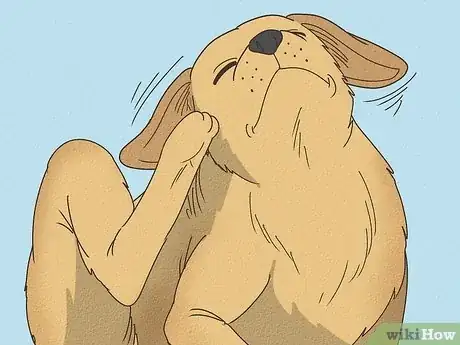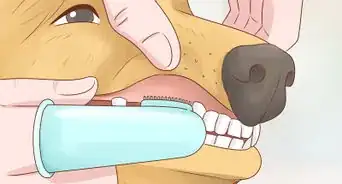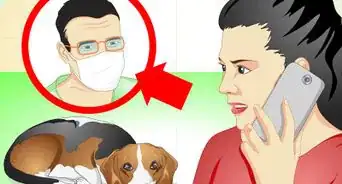This article was co-authored by Ryan Corrigan, LVT, VTS-EVN. Ryan Corrigan is a Licensed Veterinary Technician in California. She received her Bachelor of Science in Veterinary Technology from Purdue University in 2010. She is also a Member of the Academy of Equine Veterinary Nursing Technicians since 2011.
There are 11 references cited in this article, which can be found at the bottom of the page.
This article has been viewed 113,880 times.
Fleas are a real pain for you and your dog. If you notice your dog itching or scratching more than usual, check them for signs of fleas including eggs, bite marks, and flea dust. Generally, you can get rid of these pests at home using topical flea treatments such as shampoos and collars. Before anything else, though, you should talk with your vet to ensure that you are using the right treatment and the right dose for your dog.
Steps
Identifying Fleas
-
1Look for small red dots, flea dirt, and flea eggs on your dog’s skin. One of the most conspicuous signs of fleas are what they leave on your dog. Take a close look at your dog’s skin to see if they have any small, red, raised bite marks. Additionally, fleas often leave behind “flea dirt,” which will look like small, dark grains of sand, as well as small white eggs that resemble tiny grains of rice.[1]
- If your dog has an allergic reaction to the bite, the red area may be larger.
- If your dog has dark fur, run a flea comb once through its fur to check for signs of fleas. Then, tap the comb on a white paper towel to see if any flea dirt or eggs fall off.
-
2Watch your dog to see if they scratch excessively. Excessive scratching, licking, and biting at the skin is another clear sign your dog may have fleas. Watch your dog’s behavior to see if they are suddenly itching, biting, or licking at their skin more than is typical.[2]Advertisement
-
3Look for irritation and scabs on your dog’s skin. Scabs, bald spots, and inflammation can be indicative of a number of skin conditions, including fleas. If you suspect fleas, take a look at your dog’s coat to see if the they have any areas of irritation, bald spots, or scabs.[3]
- If you find any of these symptoms present on your dog, call your vet. In addition to being a sign of fleas, these symptoms could be signs of ticks, mange, and other canine skin conditions.
-
4Use a flea comb. If you think your dog may have fleas, you can buy a flea comb from most pet stores. Use the comb to check for fleas, as well as anything fleas may leave behind. Flea combs can make it easier to identify fleas, along with flea eggs and flea dust.[4]
-
5Look for jumping adult fleas. In severe cases, you may actually see adult fleas jumping on your dog’s back when it moves. Take your dog to the vet right away for treatment.
- The severity of the case also depends on your dog, so don’t panic. The vet will be able to tell you how bad it is and prescribe treatment accordingly.
Treating a Flea Infestation
-
1Check with your vet. Before using a home treatment, talk to your vet to make sure you get the right product for your dog. Different sized dogs will require different dosages, and young puppies may be too small or young for certain medications. Call or schedule an appointment with your vet to make sure you get the right flea treatment for your dog’s specific needs.[5]
-
2Use a flea shampoo to kill fleas. Flea shampoo is a fast-acting way to kill fleas on your dog. It’s a first line of defense, though, and will only last for about a week, so take your dog to the vet for a more permanent oral medication as well. Read over the packaging to make sure you apply the correct amount to the correct areas on your dog. Repeat the bath as recommended by the packaging or your vet.[6]
- Too much topical flea treatment can be irritating and potentially dangerous for your dog. Be careful about using the right amount for your dog’s size and age.
- Use your flea comb to brush out your dog after they dry to help remove any residual flea eggs.
- Applying the flea shampoo correctly should leave very little residue on your dog’s fur, but still be sure to rinse well afterwards.
-
3Apply a flea and tick prevention medication to your dog’s fur. The same medication that you use to keep fleas and ticks off your dog can be used to help kill a flea infestation. This treatment is more gradual, so it is most effective when combined with a fast-acting treatment such as a flea shampoo.[7]
- Topical treatments such as Advantage and flea collars can both help manage a flea infestation.
- Flea collars only target adult fleas. You’ll still need to treat your dog with a medication that targets the eggs and fleas in developmental stages, in case any were left over after the bath.
-
4Get a prescription for stubborn flea infestations. If your dog has a flea infestation that is causing them a severe amount of discomfort or is otherwise difficult to dismiss, make a vet appointment. Your vet can prescribe medication to get rid of a stubborn infestation, and to help keep your dog comfortable during treatment.[8]
- Always carefully follow your vet's instructions for administering the medication. Pay special attention to things like dosage, what time of day it should be administered, how many times a day it should be administered, and potential side-effects.
-
5Treat your house immediately to prevent a recurrence. Wash your dog’s bed, blankets, clothes, and cloth toys in the washer, using dog-safe detergent and the “sanitation” setting if your washer has one. Disinfect bowls and plastic toys with hot water and dish soap. To remove fleas on the floor or carpet, place a flea collar inside your vacuum bag and vacuum up your dog’s common areas. Empty the vacuum frequently.
- Flea-proofing your environment right after an infestation will get rid of any fleas or eggs that happened to fall off and escape.
Preventing Future Flea Bites
-
1Use regular flea and tick prevention. You can find flea and tick prevention in tablet, topical, and collar forms at most pet stores. Pick a method that works for your dog, and use it regularly. Apply topical treatment or administer the pill as instructed by your vet or the medication’s packaging. Likewise, flea collars should be changed as recommended by the collar manufacturer.[9]
-
2Brush them with a flea comb. Regular brushing with a flea comb can help get rid of fleas before they spread. Brush your dog weekly with a flea comb to help get rid of fleas before they can lay eggs and create a full infestation.[10]
-
3Wash your pet’s belongings weekly. Help keep fleas away from your pet by washing their bed and blankets, bowls, toys, and clothing like sweaters weekly. Use hot water and a dog-safe laundry detergent to wash fabrics, using the “sanitation” cycle if your washing machine has one. Wash your dog’s dishes and plastic toys with hot water and dish soap.[11]
-
4Keep your house clean. To keep fleas away from your dog, you need to keep them out of your home. Vacuum in the areas where your pet regularly rests, and use flea spray or flea traps around your home. This is especially important if your dog has had a previous flea infestation.[12]
- The right solution for your home will depend on your particular environment. If your dog has suffered from repeated flea infestations, opting for something like a flea bomb can help you get rid of a lot of pests quickly.
- Flea traps work well as a safety measure in homes where infestations are already controlled.
-
5Isolate any infested pets. Keep fleas from spreading from pet to pet by keeping any infested pets secure in their own space. This could include keeping a dog with a minor infestation in a room with a closed door to make sure no other pets can enter. If you have a more significant infestation around your house, you may want to take non-impacted pets to a stay with a friend or at a boarding facility until the fleas clear up.[13]
- Isolation should not seem like a punishment. Make sure your dog has access to plenty of food and fresh water, as well as comfort items like blankets, beds, and toys. Spend ample time with them every day. The point is to keep the fleas from spreading, not to ignore them or make them feel bad.
- Always wash your hands and change your clothes after you have interacted with a flea infested pet before you allow any other animals to come in contact with you.
Expert Q&A
Did you know you can get expert answers for this article?
Unlock expert answers by supporting wikiHow
-
QuestionWhat do you do when your dog has fleas?
 Ryan Corrigan, LVT, VTS-EVNRyan Corrigan is a Licensed Veterinary Technician in California. She received her Bachelor of Science in Veterinary Technology from Purdue University in 2010. She is also a Member of the Academy of Equine Veterinary Nursing Technicians since 2011.
Ryan Corrigan, LVT, VTS-EVNRyan Corrigan is a Licensed Veterinary Technician in California. She received her Bachelor of Science in Veterinary Technology from Purdue University in 2010. She is also a Member of the Academy of Equine Veterinary Nursing Technicians since 2011.
Licensed Veterinary Technician Depending on the severity of the infestation, you first need to treat your dog with an oral pill that will kill the fleas called Capstar, then you will probably need to give your pet a flea bath, and most importantly you'll need to treat your home/environment for fleas with a flea bomb. Consult with your vet to help you get rid of the problem.
Depending on the severity of the infestation, you first need to treat your dog with an oral pill that will kill the fleas called Capstar, then you will probably need to give your pet a flea bath, and most importantly you'll need to treat your home/environment for fleas with a flea bomb. Consult with your vet to help you get rid of the problem. -
QuestionWhat does a flea bite look like on a dog?
 Ryan Corrigan, LVT, VTS-EVNRyan Corrigan is a Licensed Veterinary Technician in California. She received her Bachelor of Science in Veterinary Technology from Purdue University in 2010. She is also a Member of the Academy of Equine Veterinary Nursing Technicians since 2011.
Ryan Corrigan, LVT, VTS-EVNRyan Corrigan is a Licensed Veterinary Technician in California. She received her Bachelor of Science in Veterinary Technology from Purdue University in 2010. She is also a Member of the Academy of Equine Veterinary Nursing Technicians since 2011.
Licensed Veterinary Technician
-
QuestionWhat is the best way to treat flea bites on humans?
 Ryan Corrigan, LVT, VTS-EVNRyan Corrigan is a Licensed Veterinary Technician in California. She received her Bachelor of Science in Veterinary Technology from Purdue University in 2010. She is also a Member of the Academy of Equine Veterinary Nursing Technicians since 2011.
Ryan Corrigan, LVT, VTS-EVNRyan Corrigan is a Licensed Veterinary Technician in California. She received her Bachelor of Science in Veterinary Technology from Purdue University in 2010. She is also a Member of the Academy of Equine Veterinary Nursing Technicians since 2011.
Licensed Veterinary Technician
References
- ↑ http://pesthacks.com/flea-bites-on-dogs/
- ↑ https://www.aspca.org/pet-care/general-pet-care/fleas-and-ticks
- ↑ https://www.aspca.org/pet-care/general-pet-care/fleas-and-ticks
- ↑ https://www.petful.com/pet-health/identifying-fleas-dogs-cats/
- ↑ https://www.petful.com/pet-health/identifying-fleas-dogs-cats/
- ↑ https://www.akc.org/expert-advice/health/parasites/how-to-get-rid-of-fleas/
- ↑ https://www.caninejournal.com/getting-rid-of-fleas/#chemical
- ↑ https://www.petmd.com/dog/care/evr_dg_fleas_on_dogs_and_what_you_can_do_about_them
- ↑ http://www.vetstreet.com/dogs/flea-and-tick-prevention
About This Article
To treat flea bites on your dog, start by bathing your dog with a flea shampoo to kill any fleas that are on it. Afterwards, apply a flea and tick prevention medication, like Advantage, to keep fleas off your dog after bathing. Additionally, wash your dog’s bed, blankets, clothes, and fabric toys in the washing machine using a dog-safe detergent, and disinfect its bowls and plastic toys with hot water and dish soap. Then, talk to your vet about a monthly flea prevention medication, such as a topical treatment or flea collar, to help prevent flea bites in the future. For more advice from our Veterinary co-author, including how to identify flea bites on your dog, keep reading.








































































